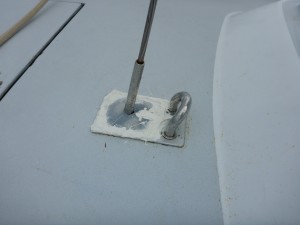Coming back from Bermuda was a very different experience.
Instead of twelve we were six. Although six is light crew for FEARLESS we made due. It’s tough to overstate the added comfort of having one’s own bunk to sleep in. When you go below you needn’t search for somewhere to sleep you just climb back into your bunk. Where you’ve had the chance to arrange your things. Where you’ve figured out the most comfortable way to situate yourself for sleeping. I had the high side bunk in the main salon under a drippy hatch, arguably the worst bunk in use. Yet on the second and third nights I managed 6 hours of continuous sleep; almost three times as long as my longest nap on the race down.

We delayed two days to hurry back between weather systems instead of being on the clock and having to bash through one. I knew that, even if it caught us the worst would pass behind us and we’d be running from it not bashing into it. Besides that, the forecast wasn’t for anything worse than the weather we’d had during the race. It was also comforting to see other race participants on AIS during the entire delivery home; after our flyer during the race this was a new experience.

Many of the tough lessons we learned on the way down benefited us during the trip back. We improved the way we had setup the reefing system. We tied up the extra sail at the foot immediately after tying in the reef. No sails would be left on deck tied to the lifelines. Our new handheld bilge pump could get water or of those hard to reach recesses of the bilge. We knew that plugging the baby stay leak below deck wouldn’t hold so we bit the bullet and plugged it on deck (with parts and a plan that we had prepped in Bermuda); a very wet job to be sure! We simplified our sail plan for easy sail handling. We got internet working aboard and could access weather forecasts.
We were delivering, not racing. The third day we were hit by a cold front with winds and rain that made the ocean appear to boil. We ran off east making 10+ knots under double reefed main and no headsail. Nobody was worried that we should change our sails so we could head north again. We rode it out for 45 minutes and then we were back on course rolling out some jib. Nobody objected when I suggested we shorten sail in advance of deteriorating conditions. When it got too light to make 8 knots we fired up the iron genoa which enabled us to make it back just in time to be cleared into the US on Wednesday.
We also lucked out in terms of crew. All six were able to function during the entire trip back; nobody was knocked out by seasickness. We had the same 16% ratio of unknown crew so this was nothing more than luck.
Perhaps the biggest difference for me was that I trusted FEARLESS. She and I had been through worse the week before, pushing harder, and had arrived reasonably unscathed. Something can always go wrong but I had learned that many of the things I worried about on the way down were the exception not the rule. (In theory I knew that already but it didn’t feel that way in the gale.) I knew what the crew could take and that we were comfortably inside their limits. And I knew we had better prepared to handle all the things that had gone bump during the race down.
With the knowledge that we gained during the race, a select few extra bits of gear, some well informed additional preparation and the ability to choose our own weather window 6 people handily managed what 12 had struggled with during the race south. There is still a huge list of improvements to be made to FEARLESS before next year that should have things running more smoothly and allow us to push the boat toward Bermuda even harder. I’m looking forward to the challenges that await us between now and the completion of next year’s Bermuda race; personally I’m 3x more experienced with offshore sailing than when we started less than 3 weeks ago 🙂
Leave a Reply